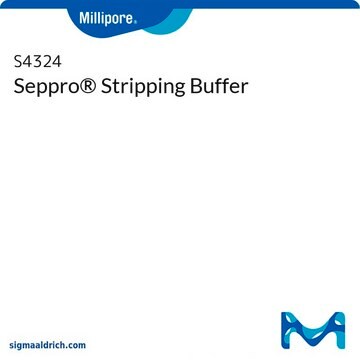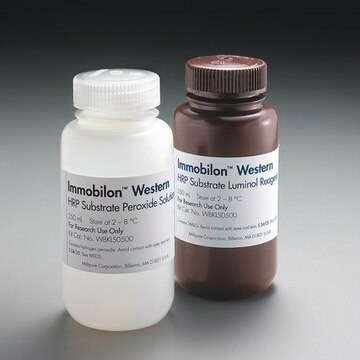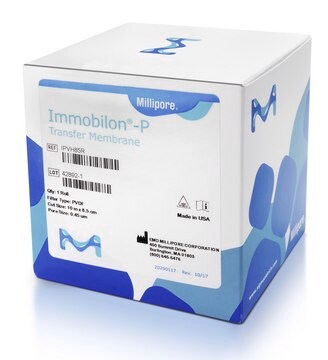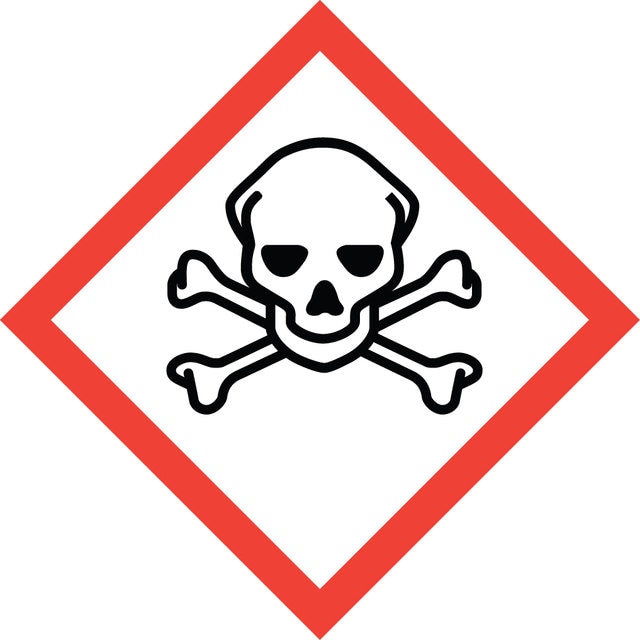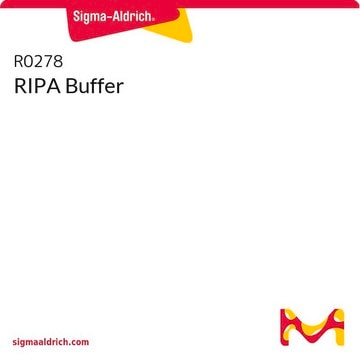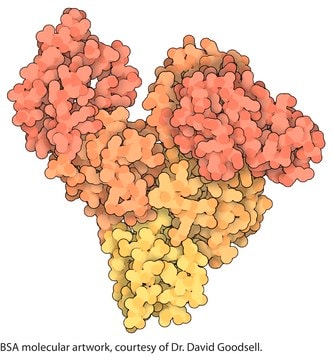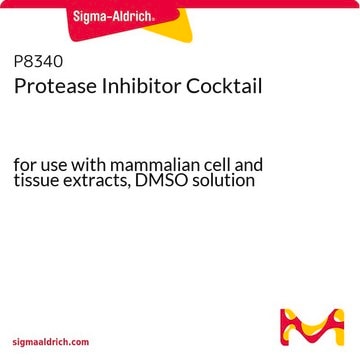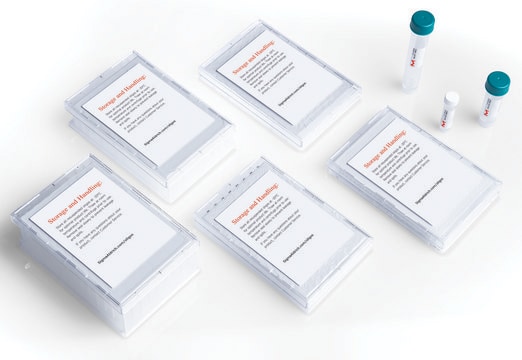추천 제품
양식
liquid
포장
pkg of 50 mL
제조업체/상표
Chemicon®
Re-Blot™
기술
western blot: suitable
검출 방법
chemiluminescent
배송 상태
wet ice
일반 설명
Western blotting is a commonly used technique for studying protein function and localization. Typically, protein samples are electro-phoresed on SDS-PAGE and transferred to a membrane such as nitrocellulose or nylon, where they are probed with specific antibodies. Unlike nucleic acid based technologies, which allow reuse of Southern and Northern blots, it has been difficult to reuse Western blots.
Stripping and re-probing of Western blots offers several advantages:
1) Conservation of samples that are expensive or available only in limited quantities,
2) Analysis of a given blot using several different antibodies, e.g. subtype- or isoform-specific antibodies,
3) Re-analysis of anomalous results and confirmation with the same or a different antibody,
4) Correcting errors in incubation with the wrong antibody,
5) Cost savings in reagents and time by reusing the same blot.
While antigen and antibody-based immunoaffinity matrices, such as Sepharose™ conjugates, have been reused many times without compromising antigen-antibody reactivity, the need for pH extremes and chaotropic agents has precluded the application of these methods to Western blotting.
The MILLIPORE Re-Blot Plus Western Blot Strong Antibody Stripping Solution contains specially formulated solutions that quickly and effectively remove antibodies from Western blots without significantly affecting the immobilized proteins.
Advantages of the Re-Blot Plus Western Blot Strong Antibody Stripping Solution include:
· No pungent-smelling b-mercaptoethanol is contained in the Antibody Stripping Solution.
· Antibody stripping is done at room temperature. No heating of blots is required.
· Blots can be stripped of antibodies in approximately 15 minutes at room temperature.
· Blots may be reused in 25 minutes.
Stripping and re-probing of Western blots offers several advantages:
1) Conservation of samples that are expensive or available only in limited quantities,
2) Analysis of a given blot using several different antibodies, e.g. subtype- or isoform-specific antibodies,
3) Re-analysis of anomalous results and confirmation with the same or a different antibody,
4) Correcting errors in incubation with the wrong antibody,
5) Cost savings in reagents and time by reusing the same blot.
While antigen and antibody-based immunoaffinity matrices, such as Sepharose™ conjugates, have been reused many times without compromising antigen-antibody reactivity, the need for pH extremes and chaotropic agents has precluded the application of these methods to Western blotting.
The MILLIPORE Re-Blot Plus Western Blot Strong Antibody Stripping Solution contains specially formulated solutions that quickly and effectively remove antibodies from Western blots without significantly affecting the immobilized proteins.
Advantages of the Re-Blot Plus Western Blot Strong Antibody Stripping Solution include:
· No pungent-smelling b-mercaptoethanol is contained in the Antibody Stripping Solution.
· Antibody stripping is done at room temperature. No heating of blots is required.
· Blots can be stripped of antibodies in approximately 15 minutes at room temperature.
· Blots may be reused in 25 minutes.
애플리케이션
The MILLIPORE Re-Blot Plus Western Blot Strong Antibody Stripping Solution is effective for removal of antibodies from Western blots that have been developed with chemiluminescence or radioactive iodine or other isotopes. It is not recommended for stripping colorimetric substrates (TMB, DAB, 4-chloronapthol, etc.), as it is not possible to effectively remove substrates that precipitate at the reaction site.
The Re-Blot Plus Western Blot Strong Antibody Stripping Solution should be used only for qualitative purposes until it has been established by comparative blot analysis that stripping does not quantitatively affect a given antigen.
This product is for research use only; not for diagnostic or in vivo use.
The Re-Blot Plus Western Blot Strong Antibody Stripping Solution should be used only for qualitative purposes until it has been established by comparative blot analysis that stripping does not quantitatively affect a given antigen.
This product is for research use only; not for diagnostic or in vivo use.
성분
Strong Antibody Stripping Solution (10x) - (2 containers, 25 mL each).
저장 및 안정성
The Strong Antibody Stripping Solution should be stored at 2-8°C upon arrival. Product is stable for 3 to 6 months after receipt. If Antibody Stripping Solution crystallizes upon storage, it may be re-dissolved with gentle warming at 37°C before use.
Note: To prevent reagent degradation secure the cap tightly upon storage. Avoid extended exposure to air.
Note: To prevent reagent degradation secure the cap tightly upon storage. Avoid extended exposure to air.
법적 정보
CHEMICON is a registered trademark of Merck KGaA, Darmstadt, Germany
Re-Blot is a trademark of Merck KGaA, Darmstadt, Germany
Sepharose is a trademark of Cytiva
면책조항
Unless otherwise stated in our catalog or other company documentation accompanying the product(s), our products are intended for research use only and are not to be used for any other purpose, which includes but is not limited to, unauthorized commercial uses, in vitro diagnostic uses, ex vivo or in vivo therapeutic uses or any type of consumption or application to humans or animals.
신호어
Danger
유해 및 위험 성명서
Hazard Classifications
Acute Tox. 3 Dermal - Acute Tox. 3 Inhalation - Acute Tox. 4 Oral - Aquatic Chronic 2 - Eye Dam. 1 - Met. Corr. 1 - Skin Corr. 1A
Storage Class Code
6.1B - Non-combustible acute toxic Cat. 1 and 2 / very toxic hazardous materials
WGK
WGK 2
Flash Point (°F)
Not applicable
Flash Point (°C)
Not applicable
시험 성적서(COA)
제품의 로트/배치 번호를 입력하여 시험 성적서(COA)을 검색하십시오. 로트 및 배치 번호는 제품 라벨에 있는 ‘로트’ 또는 ‘배치’라는 용어 뒤에서 찾을 수 있습니다.
이미 열람한 고객
Eva E Nagiec et al.
Antimicrobial agents and chemotherapy, 49(9), 3896-3902 (2005-08-30)
The oxazolidinones are a relatively new structural class of antibacterial agents that act by inhibiting bacterial protein synthesis. The oxazolidinones inhibit mitochondrial protein synthesis, as shown by [35S]methionine incorporation into intact rat heart mitochondria. Treatment of K562 human erythroleukemia cells
Anna Dzionek et al.
Molecules (Basel, Switzerland), 25(4) (2020-02-23)
The naproxen-degrading bacterium Bacillus thuringiensis B1(2015b) was immobilised onto loofah sponge and introduced into lab-scale trickling filters. The trickling filters constructed for this study additionally contained stabilised microflora from a functioning wastewater treatment plant to assess the behavior of introduced
Fiona Robinson et al.
PloS one, 3(3), e1801-e1801 (2008-03-13)
The frequency of synonymous codon usage varies widely between organisms. Suboptimal codon content limits expression of viral, experimental or therapeutic heterologous proteins due to limiting cognate tRNAs. Codon content is therefore often adjusted to match codon bias of the host
Abu Hasan Hassimi et al.
Journal of environmental management, 260, 110046-110046 (2020-02-25)
This study was conducted to examine the production of bioflocculants using agricultural wastewater as a fermentation feedstock under different temperatures and incubation times. The mechanism of flocculation was studied to gain a detailed understanding of the flocculation activity. The highest
Céline Cudejko et al.
Blood, 118(9), 2556-2566 (2011-06-04)
The CDKN2A locus, which contains the tumor suppressor gene p16(INK4a), is associated with an increased risk of age-related inflammatory diseases, such as cardiovascular disease and type 2 diabetes, in which macrophages play a crucial role. Monocytes can polarize toward classically
자사의 과학자팀은 생명 과학, 재료 과학, 화학 합성, 크로마토그래피, 분석 및 기타 많은 영역을 포함한 모든 과학 분야에 경험이 있습니다..
고객지원팀으로 연락바랍니다.